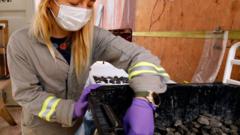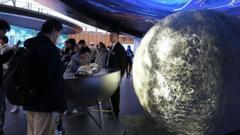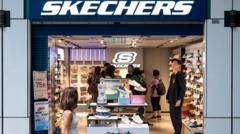**As various companies pursue advancements in humanoid robotics, the disparities in capabilities, resources, and geographic advantages can alter the landscape of this budding market.**
**Race for Humanoid Robots: Who Will Prevail?**

**Race for Humanoid Robots: Who Will Prevail?**
**A look into the competition among global firms in the humanoid robot industry.**
In Hanover, Germany, the atmosphere is charged with excitement as attendees gather at the Hannover Messe trade show, where cutting-edge technologies are showcased. Among them is the G1, a humanoid robot created by the Chinese company Unitree, which has garnered significant attention for its human-like stature and remarkable agility. Measuring approximately 4'3" (130cm), the G1 is both cost-effective and versatile, engaging the audience with its unique features, including dancing and martial arts performances that have quickly spread across social media platforms.
Pedro Zheng, Unitree's sales manager, demonstrates the G1's capabilities, highlighting the requirement for programming each robot for autonomous functions. Unlike many other robotic exhibits at the show, the G1 draws a crowd, with people instinctively reaching to shake hands and laugh at its interactive motions, creating a surprising ease despite its mechanical nature.
Unitree is just one of numerous companies globally pursuing similar humanoid robots, with the potential for various applications ranging from labor in enterprises to assistance in domestic chores. However, the complexity of developing humanoid robots suitable for unpredictable environments presents substantial challenges. Existing robots perform admirably in controlled settings, yet a reliable humanoid robot for households or restaurants still seems a distant reality.
According to Unitree, the required artificial intelligence hasn't yet reached a sufficient level of sophistication. "Today's robot AI struggles with logic and reasoning necessary for complex tasks," a representative stated, indicating current limitations. Presently, the G1 is targeted at research and tech companies that have access to Unitree's open-source software for further development.
Meanwhile, the competitive landscape of humanoid robotics sees larger corporations leading the charge. Tesla, directed by Elon Musk, is making strides with its humanoid robot named Optimus, with plans to manufacture thousands within the year. Other automotive players, like BMW and Hyundai, have begun integrating humanoid robots in their factories, following suit to enhance efficiency.
Thomas Andersson, head of the research firm STIQ, identifies a substantial number of companies—49 focused on traditional humanoid robots and over 100 when including those with rolling capabilities. He predicts a dominance from Chinese entities, attributing their edge to the robust supply chain that facilitates rapid development and government support.
In light of the competitive advantages enjoyed by Asian firms, American and European manufacturers face substantial challenges. Bren Pierce, a UK entrepreneur, has opted to manufacture his newly launched KR1 robot in Asia to cut down costs, further highlighting the outsourcing dilemma facing Western counterparts. The KR1 is designed primarily for warehouses without adopting the full humanoid form, reflecting a strategic choice to focus on utility rather than complexity.
Pierce emphasizes the significance of user-friendly software, asserting that many advanced robots require extensive knowledge to operate, which limits their practical deployment in workplaces. His objective is to ensure the KR1 is easy to use, with effective training possible within hours.
Despite ambitious aspirations for humanoid robots, the reality is that widespread applications in domestic settings remain a long-term vision. According to Pierce, creating versatile robots for homes, which he refers to as the "everything robot," could take another 10 to 15 years, showcasing the inherent challenges that lie ahead in this race.
Pedro Zheng, Unitree's sales manager, demonstrates the G1's capabilities, highlighting the requirement for programming each robot for autonomous functions. Unlike many other robotic exhibits at the show, the G1 draws a crowd, with people instinctively reaching to shake hands and laugh at its interactive motions, creating a surprising ease despite its mechanical nature.
Unitree is just one of numerous companies globally pursuing similar humanoid robots, with the potential for various applications ranging from labor in enterprises to assistance in domestic chores. However, the complexity of developing humanoid robots suitable for unpredictable environments presents substantial challenges. Existing robots perform admirably in controlled settings, yet a reliable humanoid robot for households or restaurants still seems a distant reality.
According to Unitree, the required artificial intelligence hasn't yet reached a sufficient level of sophistication. "Today's robot AI struggles with logic and reasoning necessary for complex tasks," a representative stated, indicating current limitations. Presently, the G1 is targeted at research and tech companies that have access to Unitree's open-source software for further development.
Meanwhile, the competitive landscape of humanoid robotics sees larger corporations leading the charge. Tesla, directed by Elon Musk, is making strides with its humanoid robot named Optimus, with plans to manufacture thousands within the year. Other automotive players, like BMW and Hyundai, have begun integrating humanoid robots in their factories, following suit to enhance efficiency.
Thomas Andersson, head of the research firm STIQ, identifies a substantial number of companies—49 focused on traditional humanoid robots and over 100 when including those with rolling capabilities. He predicts a dominance from Chinese entities, attributing their edge to the robust supply chain that facilitates rapid development and government support.
In light of the competitive advantages enjoyed by Asian firms, American and European manufacturers face substantial challenges. Bren Pierce, a UK entrepreneur, has opted to manufacture his newly launched KR1 robot in Asia to cut down costs, further highlighting the outsourcing dilemma facing Western counterparts. The KR1 is designed primarily for warehouses without adopting the full humanoid form, reflecting a strategic choice to focus on utility rather than complexity.
Pierce emphasizes the significance of user-friendly software, asserting that many advanced robots require extensive knowledge to operate, which limits their practical deployment in workplaces. His objective is to ensure the KR1 is easy to use, with effective training possible within hours.
Despite ambitious aspirations for humanoid robots, the reality is that widespread applications in domestic settings remain a long-term vision. According to Pierce, creating versatile robots for homes, which he refers to as the "everything robot," could take another 10 to 15 years, showcasing the inherent challenges that lie ahead in this race.






















